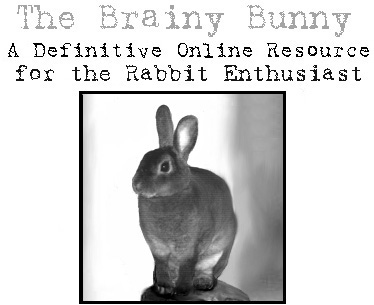









|
BIOLOGY & BEHAVIOR
 Although commonly mistaken as such, rabbits are not rodents. Rather, they are "lagomorphs" and are most closely related to horses! Although commonly mistaken as such, rabbits are not rodents. Rather, they are "lagomorphs" and are most closely related to horses!
 A female rabbit is called a "doe" and a male rabbit is called a "buck." A female rabbit is called a "doe" and a male rabbit is called a "buck."
 In the wild, rabbits live in colonies, digging long burrows known as "buries." Some of these tunnels go down as far as nine feet below the earth's surface! In the wild, rabbits live in colonies, digging long burrows known as "buries." Some of these tunnels go down as far as nine feet below the earth's surface!
 Rabbits are crepuscular: They are most active at dawn and at twilight, and sleep in during the heart of the day and night. To accommodate your companion rabbit’s schedule, let it out for playtime before you leave for work or school, and then again when you return home in the evening. Rabbits are crepuscular: They are most active at dawn and at twilight, and sleep in during the heart of the day and night. To accommodate your companion rabbit’s schedule, let it out for playtime before you leave for work or school, and then again when you return home in the evening.
 Like humans, rabbits come in all different personalities and you should not try to force your rabbit into something that he or she is not. There are shy bunnies and sociable bunnies, aggressive bunnies and docile bunnies. Whatever personality your companion rabbit has, learn to appreciate its uniqueness and be willing to spend time to gain its trust and affection. Like humans, rabbits come in all different personalities and you should not try to force your rabbit into something that he or she is not. There are shy bunnies and sociable bunnies, aggressive bunnies and docile bunnies. Whatever personality your companion rabbit has, learn to appreciate its uniqueness and be willing to spend time to gain its trust and affection.
 Rabbits grind their teeth as a sign of contentment, much as cats purr. Loud grinding, however,
signifies extreme pain; take your bunny to the veterinarian immediately if you hear it making loud grinding noises! Rabbits grind their teeth as a sign of contentment, much as cats purr. Loud grinding, however,
signifies extreme pain; take your bunny to the veterinarian immediately if you hear it making loud grinding noises!
 Rabbits are "polygamous": One buck can mate with several does. In the mating ritual, several bucks chase and fight with one another over the does. Rabbits are "polygamous": One buck can mate with several does. In the mating ritual, several bucks chase and fight with one another over the does.
 A rabbit's litter ranges from two to eight babies, but is dependent on the conditions of the mother's environment. Embryos may be reabsorbed during times of stress due to a food shortage or cold weather! A rabbit's litter ranges from two to eight babies, but is dependent on the conditions of the mother's environment. Embryos may be reabsorbed during times of stress due to a food shortage or cold weather!
 Mother rabbits vigorously defend their babies by stomping their hind feet! Mother rabbits vigorously defend their babies by stomping their hind feet!
 Mother rabbits generally nurse their young for only five minutes during the night, and disappear from the nest for the entire day! Mother rabbits generally nurse their young for only five minutes during the night, and disappear from the nest for the entire day!
 European rabbits produce two types of droppings, one of which can be eaten by rabbits! European rabbits produce two types of droppings, one of which can be eaten by rabbits! |

